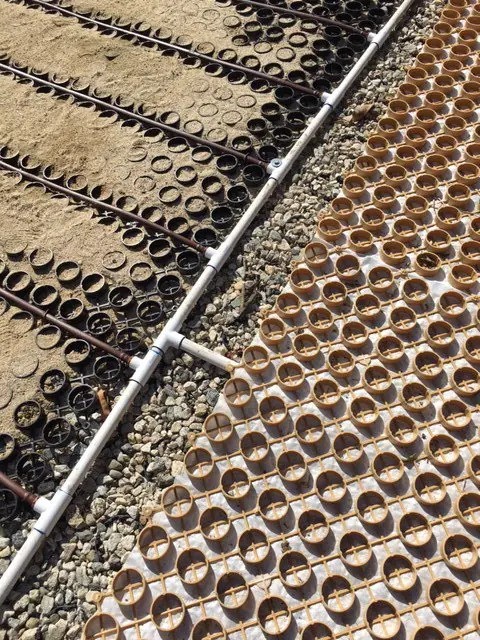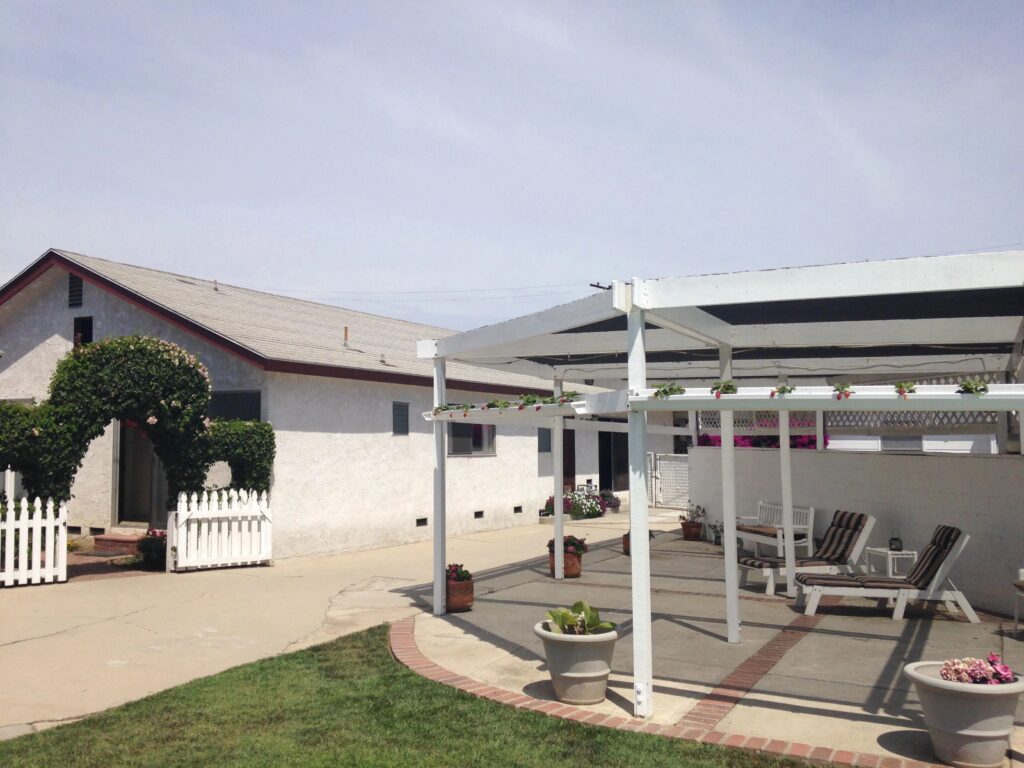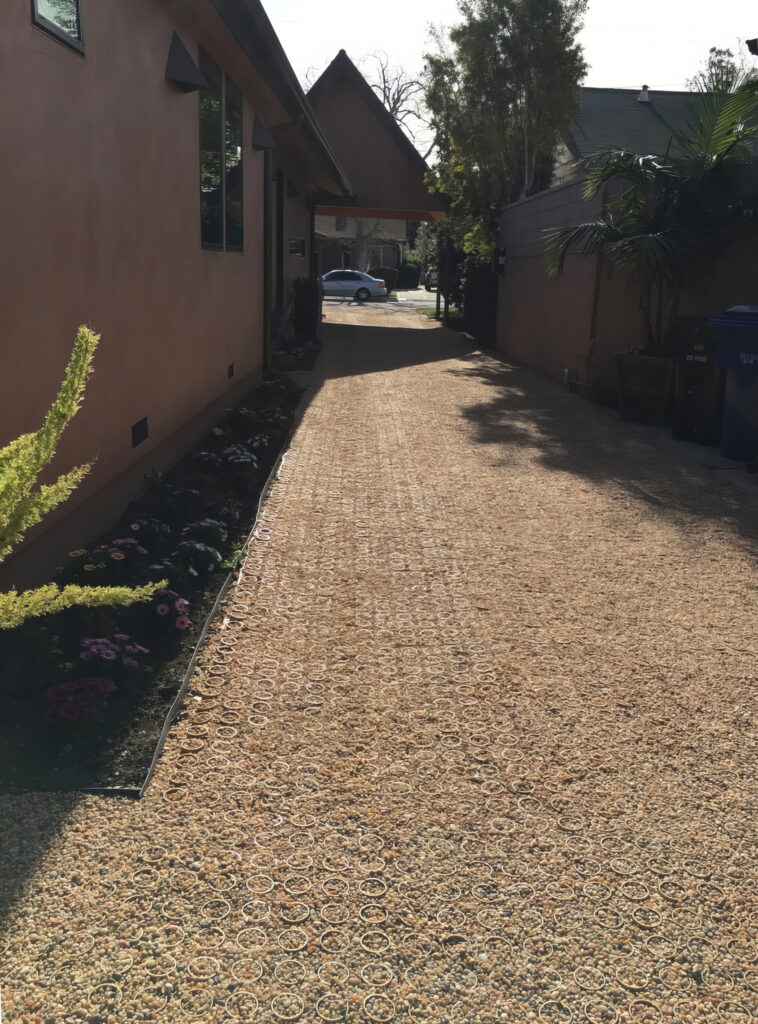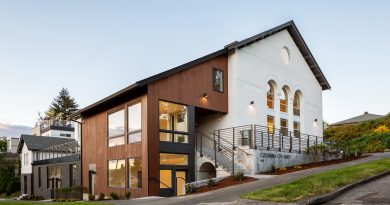Eliminating Drainage Issues
Porous Pavers for Climate-Ready Landscaping
by Olivia Harris, President, Invisible Structures
Most residential properties constructed before the 2000s were not built with today’s climate extremes in mind. Such was the case for a 1960s ranch-style house in Culver City, California, which was not equipped to handle the increasingly frequent rainstorms and atmospheric river flooding events the West Coast is experiencing. Over 50 years after its construction, the property underwent a major upgrade, which required replacing the sewer line and removing the badly cracked two-year-old concrete driveway. But the underlying soft soil did little to support the concrete.
After the new sewer lines were installed, heavy rains turned the driveway into a muddy puddle. The problem was exacerbated by vehicular movement and the grading of the property that directed rainwater from the roof and pavement to flood the existing garage. William Bohnhoff, the project’s Landscape Architect, knew there had to be a solution. “We knew that we could not continue this practice when we had better solutions available, like porous paving,” he explained.
Plastic Porous Paving Offers Multifaceted Advantages
Plastic porous pavers are flexible permeable paving systems with a grid-like structure. The unique configuration enables void spaces that can be filled with grass or gravel for stormwater management. With significantly higher drainage rates, these pavers can be especially beneficial in areas prone to extreme rains and storms. Durable and easy to maintain, porous pavers can have a high compressive material strength that is nearly five times that of concrete and therefore can readily support any vehicular weight and low-speed traffic.

After evaluating traffic volume and vehicle maneuvering needs at the residence, Bohnhoff opted for Gravelpave2 from Invisible Structures™ for the driveway entrance and front parking area. The innovative system, with its ring-on-grid design, has 92 percent void space. When filled with aggregate, it enables 38.5 inches of water drainage per sq.ft. per hour, effectively preventing puddles. In the pavers, Bohnhoff used locally sourced, light-colored, and rounded river stones. He explained that these stones contribute to a visually appealing outdoor space while reflecting sunlight, reducing heat absorption, and keeping the property cooler.
Furthermore, because the porous pavers have larger void spaces, it eliminates clogging concerns and minimizes extensive maintenance requirements. Highlighting this aspect, Bohnhoff said, “In high tire turning areas like the garage entrance and auto court, the homeowners only need to use a push broom twice a year to redistribute the rounded stones back into the top of the rings.”
Extending the benefits of the porous paving system to other areas of the property, Bohnhoff specified Grasspave2, a porous paving variation by Invisible Structures that is filled with grass, in nearly half the driveway in the backyard. Its void spaces facilitate root development and drain at 32.5 inches per sq.ft. per hour, whereas normal lawns can only drain about one to two inches per sq.ft. per hour. Because Grasspave2 has a compressive strength of 2,295,000 pounds per sq.ft., homeowners can use the green space to drive upon and increase their lawn by 15 percent.

Additionally, the side yard where the roof runoff was directed was also made porous with Gravelpave2, creating a comprehensive drainage solution for the previously concerning issue. In all, porous paving was installed on nearly 3,650 sq.ft. of the property.
Going the Extra Mile With a Water Containment System
The landscape team also saw an opportunity to capitalize on water management with a containment system. Bohnhoff explained, “We needed a strong, stable base course for the pavement. But since the area would only experience light H-20 loading from delivery trucks and cars, we could optimize it for water storage.”
To collect the runoff until it seeps into the ground and provide a stable base for the pavers, the team installed a single layer of Rainstore3. The modular and stackable underground water containment system by Invisible Structures was installed over a 12-ounce geotextile fabric and filled with a single layer of 50/50 mix of ¾-inch stone and sand for stability. Doing so made it possible to create a mere four inch base course that can support vehicles exceeding H-20 loading capacity, instead of the typical eight inch depth.

Installing the subsurface water storage system underneath the porous pavers provides the residents with significant water storage capacity. In particular, Rainstore3 stores 0.4 cubic feet of water per sq.ft.. Plus, the one inch-high porous pavers contribute 0.083 cubic feet of storage per sq.ft. with their own void spaces. Cumulatively, the setup can hold 1,760 cubic feet or over 13,000 gallons of water. The ability to store large volumes of water benefits the residents by reducing dependence on municipal water systems and reducing monthly water bills. It also helps alleviate stress on the city’s stormwater management systems.
Responsible Efforts Enable Future-Proof Landscapes
Going beyond mere functionality, the landscape design team improved the livability factor for the homeowners while creating an earth-friendly property by capitalizing on the potential of an efficient water management solution. Invisible Structures manufactures all its products from 100 percent recycled plastic, diverting plastic from landfill materials, about 1.5 million pounds a year company-wide. Utilizing recycled products with a circular approach helped the project team minimize energy use and carbon emissions associated with manufacturing products with virgin materials. For context, reprocessing resins into plastic requires 88 percent less energy than producing plastic from raw gas or oil.

This residence in Culver City serves as a compelling example of how innovative materials and thoughtful landscape design can address contemporary challenges. By replacing traditional concrete with a porous paving system, the project not only eliminated drainage issues but also transformed the property into a leader in stormwater management. This forward-thinking approach demonstrates the potential for sustainable landscaping solutions that are both aesthetically pleasing and have proven effective in the face of extreme weather and stormwater management concerns.



